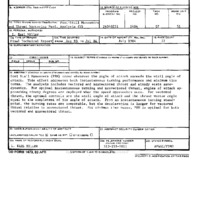-
Title
-
Post Stall Maneuvers and Thrust Vectoring Performance Analysis
-
Date
-
1984
-
Index Abstract
-
Coming Soon
-
Photo Quality
-
Not Needed
-
Report Number
-
AFWAL TR 84-3109
-
Corporate Author
-
Highspeed Performance Branch, Aeromechanics Division
-
Laboratory
-
Flight Dynamics Laboratory
-
Date Issued
-
1984-07-01
-
Extent
-
77
-
Identifier
-
ADA158100
-
Access Rights
-
Approved for public release; distribution unlimited
-
Distribution Classification
-
1
-
Contract
-
Laboratory Research - No Contract
-
DoD Project
-
2404
-
DoD Task
-
240407
-
DTIC Record Exists
-
No
-
Distribution Change Authority Correspondence
-
None
-
Abstract
-
The purpose of this effort was to determine whether or not there are any apparent performance improvements through Post Stall Maneuvers (PSM) or thrust vectoring. PSM is a result of high angles of attack, greater than the stall value. Two different problems were addressed. The first examined instantaneous turning performance. The second focused on minimum time turn problems. The impact of both vectored and nonvectored thrust was considered. It was proven that minimum time turns fall in the vertical plane. For maximum instantaneous turning rate and nonvectored thrust high angle of attack results if the speed is less than the critical speed which is approximately Mach 0.2. The optimal angle of attack approaches ninety degrees as the speed approaches zero. For vectored thrust, the stall angle of attack is optimum and the thrust vector angle is the complement of the angle of attack. PSM is not optimal if thrust vectoring is available. For minimum time turning performance, maximum thrust is optimal. At the end of the trajectory, the optimal angle of attack equals that for maximum instantaneous performance. PSM is optimal. As the thrust to weight ratio increases, the maximum angle of attack increases.
-
Report Availability
-
Full text available
-
Provenance
-
AFRL/VACA
-
Type
-
report
-
Format
-
1 online resource
-
Creator
-
Miller, L. Earl
 AFWALTR84-3109.pdf
AFWALTR84-3109.pdf